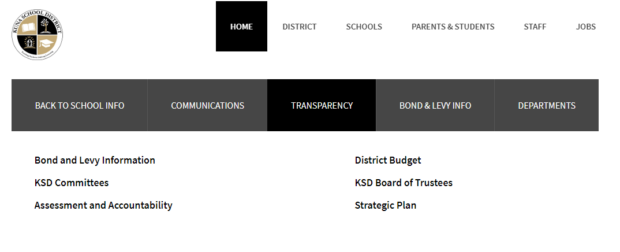Most of Idaho’s school districts are almost compliant with website transparency laws -— but only half the state’s school districts actually satisfied every regulation.
An Idaho Education News review of 158 school districts and charters found that 86 comply with five different requirements for internet transparency established by state law.
Those include: having financial information – including budgets and audits – easily accessible, posting all vendor and personnel contracts, updating monthly expenditures, posting board meeting agendas within required time limits, and having the school’s strategic plan posted online.
About 54 percent of school districts checked the boxes in all five categories — a major improvement from EdNews’ web review in 2015, when only 14 of 164 school districts across the state were in complete compliance with the law.
Almost all of the state’s districts complied with most regulations — 83 percent of schools hit at least four of those five benchmarks.
The biggest hurdle for school district compliance was updating financial information regularly.
State law requires districts to update spending information “at least monthly.”
About 70 percent of schools hit this benchmark when EdNews reviewed websites between June 20 and July 10.
Districts that didn’t ran the gamut from some of the smallest to the largest in the state. All districts contacted by EdNews said they would update the materials.
“The smaller the districts, the more hats they [employees] wear,” said Lapwai superintendent, David Aiken. “It’s a team approach. I am fortunate to have really tech-savvy staff here at the district.” Lapwai is up to date with all of its required information.
In Meadows Valley — a school district of about 150 students located northwest of McCall – superintendent Mike Howard said he would take the blame for missing the one-month deadline for financials.
Howard only works part-time in the district. The school’s principal oversees everything from Pre-K to 12th grade. The office secretary is the registrar and also the band-aid provider.
Even with limited resources, Meadows Valley met four of five web requirements reviewed by EdNews.
“It makes me wonder who looks at that stuff,” Howard told an EdNews reporter. “We put it on there, and no offense to you, who looks at it besides you guys making sure we put it on there?”
While most websites did have materials posted, finding them was often a chore. The state’s law says that school financial information should be “easily accessible from the main page of the education provider’s website.”
EdNews didn’t use this as a measure to gauge whether schools were in compliance. However, a journey through more than 150 websites did illuminate some challenges with “easy access.”
Even on websites that met all of the financial criteria, the documents were not always easy to find. Tracking them down required intuitive guessing — financials were filed under all kinds of labels, from “financial disclosures” to “public reports,” and the information was not always found directly accessible from a site’s main page.
Another part of district finances that must be posted on the website are all district contracts — from the teachers’ to the superintendent’s. These were also often difficult to find. Some were labeled “Human Resources” while others were a link at the bottom of the Board of Trustees’ section of the website.
Each district maintains its own online presence, and the wide variation in website organization made finding some information difficult.
However, some websites were intuitive and easy to navigate.
The Kuna School District, for example, provides the required information in an easily accessible way. Under a heading titled, “Transparency” on the homepage, one can easily find all of the state-required information.

Notes on the review: Idaho Ed News conducted the website review from June 20th through July 10th. Each charter and school district website was manually searched for the five separate items required by state law: strategic plan, financial information, contracts, master labor agreement, and school board agendas. The financial information and contracts were also reviewed to verify that they were up to date within the month, as required by Idaho law. Because the audit began in mid-June, “updated” meant current as of April 2019 to verify the same requirements for all school districts.
